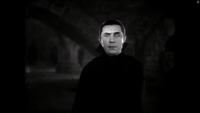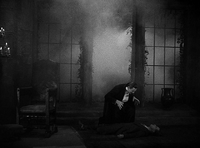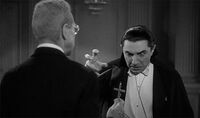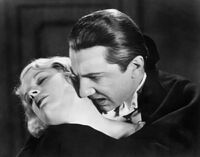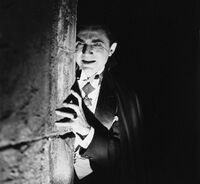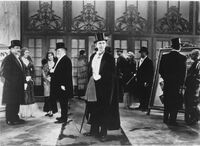| “ | The children of the night! What music they make! | „ |
| ― Count Dracula's most famous line. |
Count Dracula is the titular main antagonist of the 1931 Universal horror film Dracula. He is also the father of Countess Marya Zaleska from Dracula's Daughter and Alucard from Son of Dracula. He is based on the character of the same name in Bram Stoker's original novel Dracula, himself based on the real life Romanian prince Vlad Tepes III. He is the main antagonist in the Universal Classic Monsters franchise.
He was portrayed by the late Bela Lugosi (who also played another horror icon, Frankenstein's Monster, in Frankenstein Meets the Wolf Man) in the first film, as well as Abbott and Costello Meet Frankenstein, the late Carlos Villarías in the Spanish version, and the late John Carradine in the two sequels House of Frankenstein and House of Dracula.
Origin
Count Dracula is a vampire that through a deal with the devil has existed for centuries, also the character is of Transylvanian nobleman birthright and is a practitioner of sorcery. The character has claimed to be of Szelsky origin and related to Atilla the Hun.
Dracula maintains residence in a ruined castle in the Carpathian mountains near The Borgo Pass, situated in far Eastern Europe which has become quite a popular setting for the character.
Universal Dracula
Nearly a decade after the release of Nosferatu, Universal developed a remake (Dracula) starring Bela Lugosi, that would turn him from a minority silent film artist to one of the greatest film stars of all time. Dracula was released on the February 3, 1931 and marked the beginning of the Golden Age of Horror, the period in which films with sound revolutionized the horror genre and some of the greatest horror monsters of all time made their eternal mark on film history.
Dracula (1931)
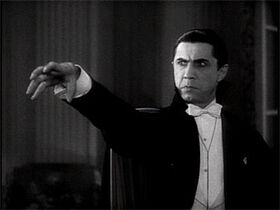
Bela Lugosi as Dracula considered the greatest Dracula ever to appear on the silver screen
Universal released Dracula on the February 3, 1931. The highlight of this film was not only that it was the first motion picture widely distributed with sound, but also because it introduced seasoned screen and stage actor, Bela Lugosi, who had previously starred in the stage adaptation of the same name.
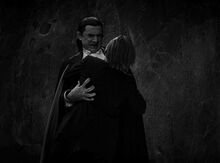
Below is a scene from the original Dracula in which the count encounters Van Helsing. On Walpurgis night, Renfield (Dwight Frye), a British solicitor, travels to The Borgo Pass (residence of Dracula), where he is met by the Count's coachman, who takes him to the local town along with several other people who travel with him, but soon the other residents of the carriage begin to grow fearful and as they notice the sunset, they order the driver to stop. The residents arrive safely at the town before sundown. Renfield insists on arriving at the Count's castle, but the residents of the town beg him to stay at the inn. Renfield refuses and Dracula’s coach driver takes Renfield to the Count's castle, where he is baffled by the site of the decaying castle and by the display of wildlife & cobwebs before being greeted by Count Dracula (Bela Lugosi). Renfield is guided to the main sitting room by Dracula to discuss the terms of Dracula’s purchase of Carfax Abbey. Later in the evening, Dracula and Renfield retire, but little does Renfield know that Dracula was going to hypnotize him into being his slave. The two then set sail for England and bring with them the unspeakable horror of Dracula.
After Lugosi
After Bela Lugosi left Universal Studios briefly, only one actor was chosen to play the part of Dracula, John Carradine, who portrayed more true to the novel, Dracula, who reflected a British accent and a more sympathetic personality seeking to end his vampirism. Some fans were disappointed for the disappearance of Bela Lugosi, however they enjoyed Carradine's performance. His performance lasted through The House of Frankenstein and The House of Dracula. While the 40's was a quiet year for Dracula after the first film, a sequel, Dracula's Daughter, was made starring Gloria Holden. Nearly a decade later, a second sequel was made called Son of Dracula, in which Lon Chaney, Jr. stars as Count Alucard, the son of Dracula. However, one comedy horror film starring two globally acclaimed comedians, Abott and Costello, would be released in 1948 and would mark the second and last appearance of the greatest Dracula of all time.
Abbott and Costello meet Frankenstein
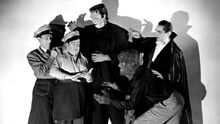
Abbott and Costello Meet Frankenstein was released theatrically in 1948 and marked the final Dracula appearance of Bela Lugosi it also marked the end of the first half of the twentieth centuries Gothic horror as afterwards horror in the United States would be largely dominated by Sci-fi horror films such as The Creature from the Black Lagoon.
Synopsis
Chick Young and Wilbur Grey are two baggage boys at the La Mirada hotel Florida, but when Wilbur accidentally mishandles two crates belonging to MacDougal's House of Horrors' museum Mr MacDougal orders that the two deliver the crates personally to an insurance agent, but not before bragging to Wilburs girlfriend that both the crates contain the remains of the original Count Dracula (Bela Lugosi) and the body of the Frankenstein monster (Glenn Strange). And after that the two set off for Transylvania not knowing what crazy misadventures the two will experience.
End of the Golden Age
Abbott and Costello Meet Frankenstein marked the end of the Golden age of horror films and would give Dracula a decade long rest before he would appear again.
Hammer
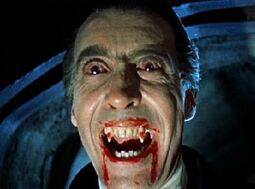
Christopher Lee as Dracula widely recognised as the second greatest of all time
A decade after Abbott and Costello Meet Frankenstein was released and the horror genre seemed all but swept away by the global wave of B-movie sci-fi films Hammer a studio in England was responsible for reviving the then hard to find genre of gothic horror and reviving it with the use of realistic blood, motion picture colour, and explicit violence. But the Hammer series of Dracula was popular not only for these revolutionary factors but for the appearance of the man now widely considered as the second greatest Dracula of all time: Christopher Lee.
Dracula 1958
27 years after the original Dracula opened in theatres Hammer released their version of the classic Universal monster Dracula which was very highly acclaimed for the onscreen performance of Christopher Lee, the film marked the beginning of a long series of Dracula Gothic Horror films from the late 1950s to the early 1970s
Synopsis
Young Jonathan Harker arrives at Castle Dracula posing as a librarian he is startled to find a young woman rushing up to him stating that she is a prisoner under Count Dracula she begs for his help in escaping until she runs away moments before the count (Christopher Lee) appears. The count politely greets Mr Harker before guiding him to his room and stating, "I have to go out and I will not be back until after sundown tommorow", before leaving Dracula and Harker browse several pictures of Harkers fiancee Lucy. After that Dracula leaves the room and locks Harker in. Whilst in his room Harker opens his bag and states his true intentions in his journal, he's here to kill Count Dracula.
Sequels
The Massive success of Dracula gave rise to a popular audience and a market for Dracula Sequels, Brides of Dracula was the first attempt at a sequel and oddly didn't include the Count at all, but rather his Possessed Brides. Brides of Dracula however did not live up to expectations and in 1966 Christopher Lee reprised his role of Count Dracula in the 1966 Gothic Horror Dracula Prince of Darkness. Dracula prince of Darkness was quite highly rate amongst Dracula fans for it's use of vivid imagery including the pseudo-Eucharistic ritual that resurrects Dracula, the staking of Barbara Shelley and the Count's demise in the icy waters of his moat, a memorable sequence acted mainly by stuntman Eddie Powell.
However over time Christopher Lee was increasingly unsatisfied with the lack of imagination in the latter Dracula films such as Scars of Dracula or Taste the blood of Dracula and after The Satanic Rites of Dracula left Hammer thus ending the Hammer era and ending the greatest years of Dracula.
After Hammer
Only three years after The Satanic rights of Dracula was released the BBC made another version of Count Dracula only this time in the television format however this version was more faithful to the novel than any other adaptation that had appeared previously and unlike previous adaptations he was portrayed as being a very young even seductive male. However there were no true horror films including Dracula during the latter half of the 70's and it wouldn't be until 1987 that Dracula would again be widely recognised along with several other Universal monsters in the Monster Squad. However, Dracula would finely be given the chance to have a film to himself again in Bram Stoker's Dracula.
John Badham
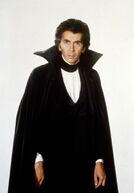
Frank Langella as Dracula
21 years after Hammer's remake of Dracula, acclaimed director John Badham directed and released his own remake of the classic tale starring Frank Langella as Count Dracula and Sir Laurence Olivier as Abraham Van Helsing.
Synopsis
In Whitby, England in 1913, Count Dracula (Frank Langella) arrives from Transylvania via the ship Demeter one stormy night. A sickly Mina Van Helsing (Jan Francis), who is visiting her friend Lucy Seward (Kate Nelligan), discovers Dracula's body after his ship has run aground. The Count visits Mina and her friends at the household of Lucy's father, Dr. Jack Seward (Donald Pleasence), whose clifftop mansion also serves as the local asylum. At dinner, he proves to be a charming guest and leaves a strong impression on the hosts, especially Lucy. Less charmed by this handsome Romanian count is Jonathan Harker (Trevor Eve), Lucy's fiancé.
Later that night, while Lucy and Jonathan are having a secret rendezvous, Dracula reveals his true nature as he descends upon Mina to drink her blood. The following morning, Lucy finds Mina awake in bed, struggling for breath. Powerless, she watches her friend die, only to find wounds on her throat. Lucy blames herself for Mina's death, as she had left her alone.
At a loss for the cause of death, Dr. Seward calls for Mina's father, Professor Abraham Van Helsing (Laurence Olivier). Van Helsing suspects what might have killed his daughter: a vampire. Moreover, he begins to worry about what fate his seemingly dead daughter may now have. Seward and Van Helsing investigate their suspicions and discover a roughly clawed opening within Mina's coffin which leads to the local mines. It is there that they encounter the ghastly form of an undead Mina, and it is up to a distraught Van Helsing to destroy what remains of his own daughter.
Lucy has, in the meantime, been summoned to Carfax Abbey, Dracula's new home. She reveals herself to be in love with this foreign prince and openly offers herself to him as his bride. After a surreal "wedding night" sequence (employing lasers and shot by famed James Bond title sequence designer, Maurice Binder), Lucy, like Mina before her, is now infected by Dracula's blood. The two doctors manage to give Lucy a blood transfusion to slow her descent into vampirism, but she remains under Dracula's spell.
Now aided by Jonathan, the elderly doctors realize that the only way to save Lucy is by destroying Dracula. They manage to locate his coffin within the grounds of Carfax Abbey, but the vampire is waiting for them. Despite it being daylight, Dracula is still a very powerful adversary. Dracula escapes their attempts to kill him, bursts into the asylum to free the captive Lucy, and also murders his one-time slave, Milo Renfield (Tony Haygarth), for warning the others about him. Dracula now intends for him and Lucy to return to Transylvania together.
In a race against time, Harker and Van Helsing just manage to get on board a ship carrying the vampire cargo bound for Romania. Below decks, Harker and Van Helsing find the Count's coffin; upon opening it, they see Lucy sleeping beside Dracula. Again they try to destroy him, but the Count awakens and once more fights with them. In the struggle, Van Helsing is fatally wounded by Dracula as he is impaled by the stake intended for the vampire. As the enraged Count now turns his attention to Harker, Van Helsing uses his remaining strength to throw a hook (attached to a rope from the ship's rigging) into Dracula's back. Harker seizes his chance and hoists the Count up through the cargo hold and into the sunlight above, and Dracula suffers a slow and painful death as the solar rays burn his body.
Lucy, now apparently herself once more, reaches out to Harker, who stares at the dead Van Helsing. At this moment, she looks up to see Dracula's cape flying away in the wind, and smiles enigmatically which hints that Dracula may have survived.
Bram Stoker's Dracula
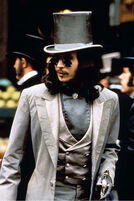
Gary Oldman as Dracula
13 years after Badham's remake of Dracula, acclaimed director Francis Ford Coppola directed and released his modern remake of the classic tale starring Gary Oldman as Count Dracula. It would be Dracula's first globally successful film since Hammer's take on the tale and began the process of drawing Dracula back into the popular culture. The title of the movie also drew attention to Bram Stroker's original novel, and short stories, which are now in public domain and available online to read for free.
Synopsis
Unlike previous Dracula films it begins with a prologue scene where Vlad III the Impaler fights for Romania as a knight in the Order of the Dragon. He defeats a massive Turkish invasion in 1462. Upon returning home, he finds his beloved wife Elisabeta (Ryder) dead, having committed suicide upon hearing the false reports of his death in battle. Enraged at his wife being eternally damned as a suicide, Dracula desecrates his chapel and renounces God, declaring that he will rise from the grave to avenge Elisabeta with all the powers of darkness. Four centuries later in the year 1897 Jonathan Harker (Keanu Reeves) travels to Castle Dracula in Transylvania to discuss the terms of the purchase of Carfax Abbey in England the Counts newest real estate purchase. At Castle Dracula the atmosphere is very bizarre almost as if there were something at work, for instane shadows that move by themselves and rooms full of unnatural objects. After meeting with the count (Gary Oldman)a pale and wrinkled old man wearing dashing red robes discuss the terms of the purchase and sign the real estate papers, afterwards the count is seen carresing a picture of Harkers Fiancee Mina Murray the reincarnation of his long dead wife Elisabeta. And after a dramatic confrontation between Harker Dracula and his brides sets sail for England on the Demeter and leaves Harker at the mercy of his bloodthirsty and insatiable brides who leave him drained and too weak to escape.
Response
The film was quite highly praised for both the performance of its cast and the visionary filming technique it used. However the film was dismissed by die hard fans of Dracula for it's extremely noticeable and drastic plot changes for instance: In the film Dracula rapes Lucy, in the book he doesn't, the film plot centres around the love between Mina and Dracula, whereas in the book there is no romance at all between the two characters. Francis Ford Coppola recewived generally negative reviews from people who watched the film because of this.
Alternate Forms
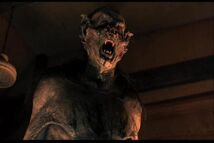
The bat form of Gary Oldman's Dracula
Bram Stoker's Dracula, among other things, was appreciated for its alternate forms of the title character, which were the forms of a bat and a wolf, but both were more anthropomorphic than previous films. The forms also played a vital role in the overall plot due to the fact that they were used Frequently in the film.
To the side of this section is a trailer of Bram Stokers Dracula which highlights all the forms of Dracula and also highlights some of his many supernatural powers.
Van Helsing
Van Helsing was the most recent attempt at portraying Dracula and while strictly not entirely a horror film it has quite a promising personality for Dracula and has pleased many fans of Dracula worldwide. The film recreated the sort of personality of Bela Lugosi seen in the original Dracula more than 83 years before, and even successfully made a chilling Hungarian accent like the one used by Bela Lugosi in the original. It also established the fact that Dracula cannot be killed by traditional vampire hunting methods such as holy water or even the stake, but that the count can only be killed by a Werewolf.
Synopsis
The film begins in 1887 at the castle of Henry Frankenstein who has brought his monster to life, however his triumph is cut short when an angry mob infiltrates castle Frankenstein. The action then returns to the castle where it is revealed that he has been aided in his experiments by his deformed assistant Ygor and the legendary Count Dracula, who later reveales that he helped Frankenstein create his creature for his own purposes and kills the doctor just as the monster wakes up and throws a large object at the count causing him to fly into the fireplace of the laboratory. The Frankenstein monster heads to the Winmill with his fathers corpse where the villagers chase him and set the windmill on fire.Where the Monster seems destroyed and Dracula stairs in dissapontment not knowing if he can begin his plan.
Response
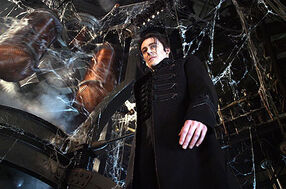
Richard Roxburgh as Count Dracula reminiscent of Bela Lugosi's performance more than 73 years earlier
The film received a generally very posotive response from movie fans for renergising the character of Dracula, and revitalising the character of Dracula to show to a modern audience and for the performance of Richard Roxburgh as the count.
The film was very popular in both the United States and Europe and had a cast of mixed ethnic backgrounds.
Parodies and references in popular culture
The character of Dracula has been parodied and referenced several times in fact the number of films with reference to Dracula is so far 649. For instance, the plot for the 1995 comedy Dracula: Dead and Loving It takes much of its plot and humor from scenes from Dracula movies throughout the years and was released three years after Bram Stoker's Dracula.

